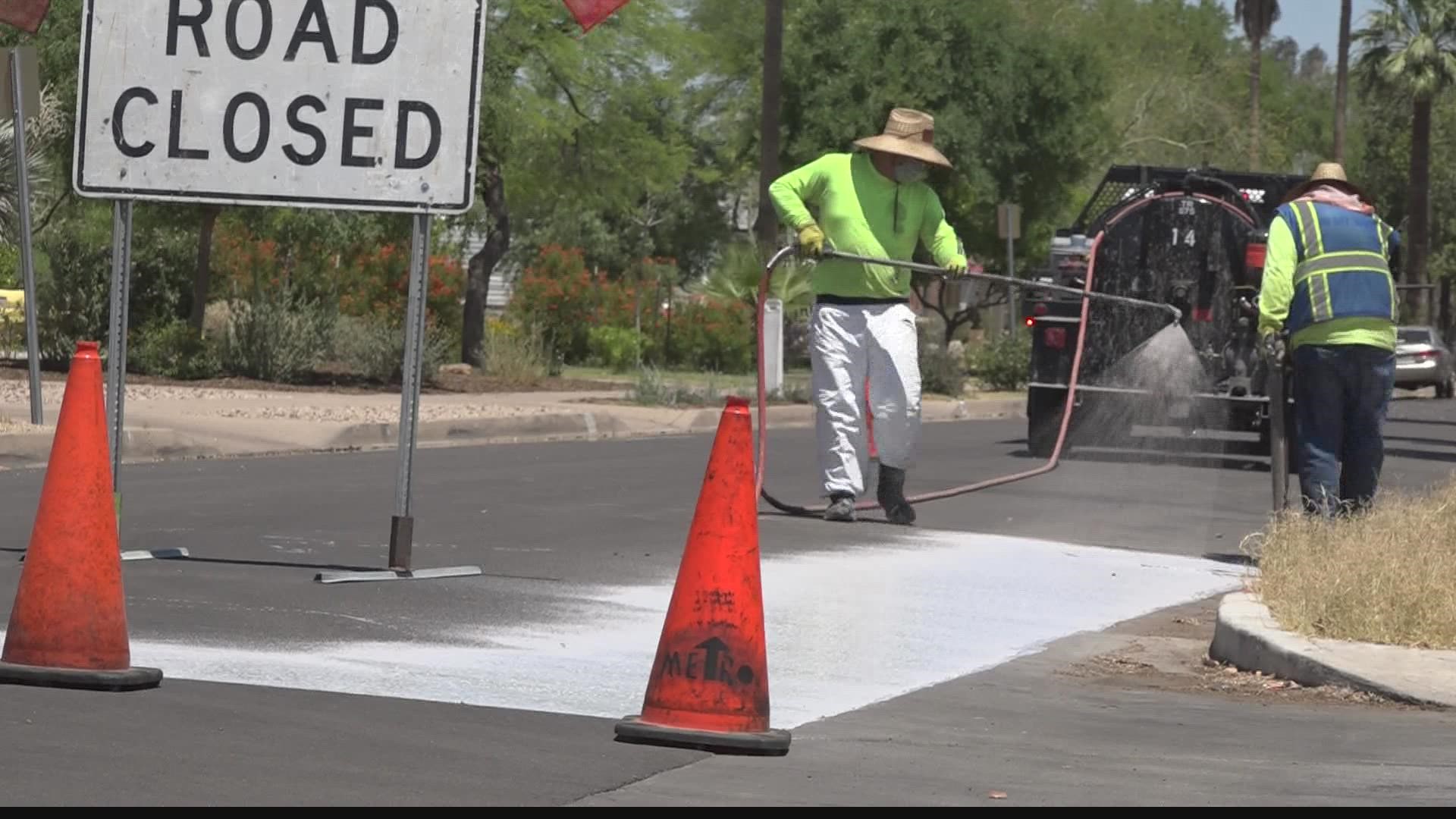PHOENIX — With the hot temperatures of summer now back in the Valley, the City of Phoenix is spraying more coating down on neighborhood streets as part of its Cool Pavement Pilot Program.
The pavement project has had results that City leaders believe could help address some of the urban heat island effects Phoenix and the Valley experience.
Reflect instead of absorb
The pavement is a thin grey coating that’s sprayed onto the existing asphalt on city streets.
“Instead of holding heat and slowly releasing at night, the streets now reflect sunlight away,” David Hondula, is the City of Phoenix’s Director of Heat Response and Mitigation.
Currently, just neighborhood streets and parking lots have been treated with the coating so far.
“When we look at satellite imagery of the city, we see that road surfaces really pop as some of the hottest surfaces in the city, adding to that heat island effect,” Hondula said.
The City of Phoenix has partnered with Arizona State University researchers and has already found that the surface temperature of this pavement is cooler, by at least 10 degrees where the reflective coating’s been applied.
The surface temperature is also lower on the bottom of the pavement too.
“The pavement material itself experiences less strain as the summer goes along, that can help it last longer, which could mean money saving for all of us,” Hondula said.
Urban heat island effect in Phoenix
In Phoenix, the urban heat island effect shows up as hotter temperatures in the city versus outlying, rural areas.
Pavement retaining heat during the hot summer days, and releasing it after the sun goes down makes temperatures hotter.
“It’s constantly evolving,” Matei Georgescu with ASU’s School of Geographical Sciences and Urban Planning said.
Georgescu said lows in Phoenix not getting as low as before in the summer months takes a toll.
“That becomes very difficult for a lot of folks that are working outside, that becomes from an energy infrastructure, a very difficult issue because air conditioners are on constantly,” Georgescu said. “And so there’s a lot of societal impacts along the way.”
As for what those living in the Valley should expect for this summer, Georgescu said the dry climate the West is experiencing right now will likely have an impact.
“That means that the land surface is going to heat up quite a bit faster than it normally does, and potentially lead to a quicker onset of the North American Monsoon System. That’s actually good news,” Georgescu said.
The monsoon starting earlier could bring needed rain. However, if thunderstorms come with no rain, then that can lead to harmful forest fire impacts.
As for the future of understanding the urban heat island effect in the Valley, Georgescu said with Phoenix growing and greenhouse gas-induced climate change both have warming effects.
Hoping more can be understood about how the two impact how much rainfall the Valley will get.
“For Phoenix, it's super important because our monsoon season is characterized by kind of extreme downforce, right? So if we can say if we can have some confidence in saying, well, the city is either gonna increase by 10, or 20, or 30%, or maybe decreased by 10, or 20, or 30%, that directly translates into impacts, streamflow, flooding,” Georgescu said.
Working to "cool" the city
Hondula said his office is working to try and cool Phoenix in a variety of ways and help make it safer for people when it’s hot.
The housing crisis is one piece concerning Hondula right now, as those without consistent shelter are most at risk for heat-related deaths.
“Anything we can do to open more cooling centers and create more affordable housing in the city, those can pay big dividends in terms of public health,” Hondula said.
In addition to installing the cool pavement in neighborhoods, Hondula said his office is working to add more trees and other vegetation to the city.
For the next phase, the cool pavement is being installed through mid-June in various neighborhoods. Hondula said he’s hoping to find answers to how long the coating lasts and how durable it is out in the real world.
Currently, the pavement is just on neighborhood roads.
Hondula said researchers have found that the reflectivity makes people walking on the surface feel hotter, so a different solution will be needed for other roads.
Researchers found the human experience at noon and in the afternoon was 5.5 degrees higher.
"In most places around the city, we don't see a lot of people walking on the centerline of the street. But this speaks to this effect on the human energy balance, it's called," Hondula said. "The fact that this can reflect more sunlight into the body speaks to our need to be thoughtful about where to deploy different cooling strategies."
Hondula is asking for public feedback on the program as they continue testing the coating on new streets.
“We think that this particular innovative strategy can help offset some of the heat island effects associated with all that pavement,” Hondula said.
While the department is working with other city departments to work on ways to cool the city, Hondula said there are volunteer opportunities for people to help keep Phoenix residents cool. Those can be found here.
VERSIÓN EN ESPAÑOL: 'El pavimento frío' mantiene bajas las temperaturas en Phoenix
Up to Speed
Catch up on the latest news and stories on the 12 News YouTube channel. Subscribe today.

